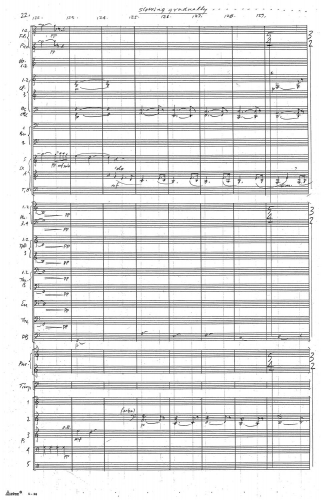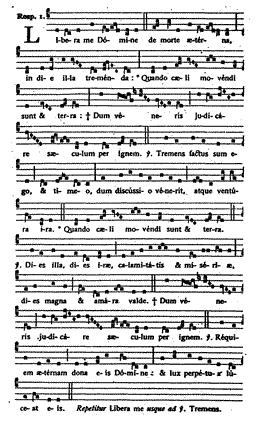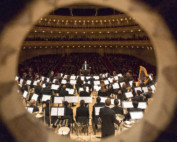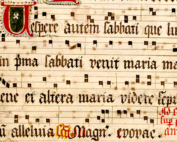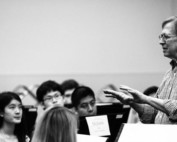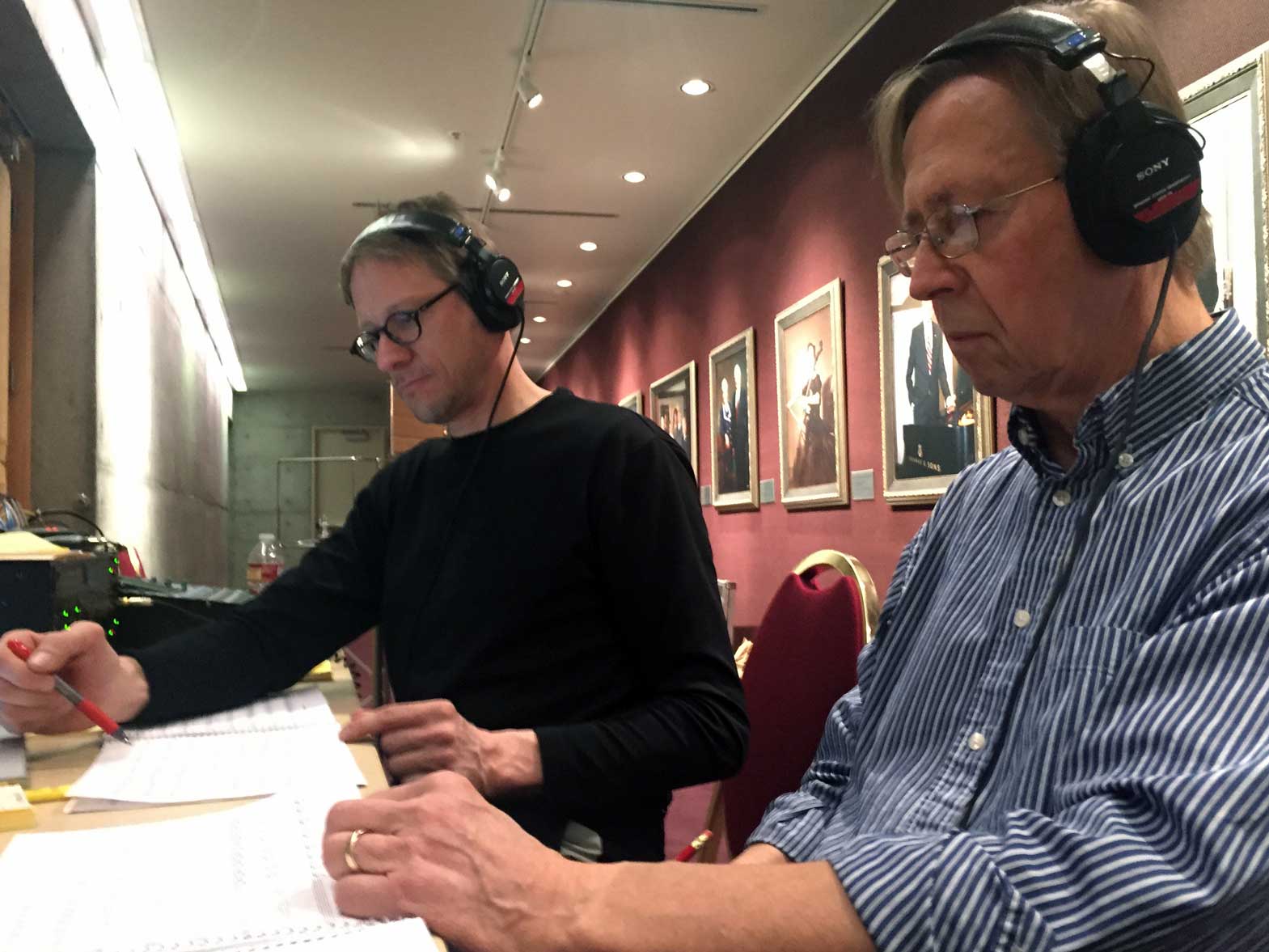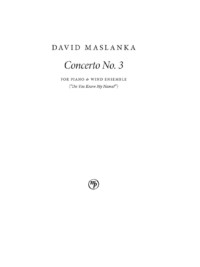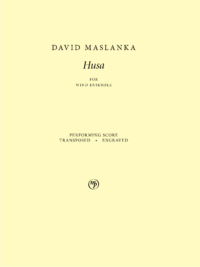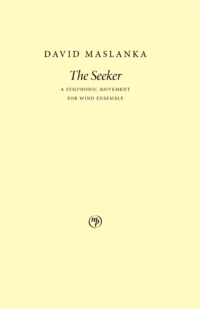Project Description
Wind Ensemble
2010
17 min.
Grade 6
Listen Now
University Of Utah Wind Ensemble, Scott A. Hagan, cond.
On the album The Music of David Maslanka, Vol. 2
Illinois State University Symphonic Winds, Stephen Steele, cond.
On the album Liberation
Instrumentation
Fl-3(2»AFl, 3»Picc) Ob-2 BbCl-3 BCl CbCl Bsn-2(2»CBsn) SSx ASx TSx BSx | Hn-4 Tpt-3 Tbn-2 BTbn Euph Tuba DB | Pno Timp Perc-6 Chorus*
- Flute (3)
- Flute 2 dbl Alto Flute
- Flute 3 dbl Piccolo
- Oboe (2)
- Clarinet in B♭ (3)
- Bass Clarinet in B♭
- Contrabass Clarinet in B♭
- Bassoon (2)
- Bassoon 2 dbl Contrabassoon
- Soprano Saxophone
- Alto Saxophone
- Tenor Saxophone
- Baritone Saxophone
- Horn in F (4)
- Trumpet in B♭ (3)
- Trombone (2)
- Bass Trombone
- Euphonium
- Tuba
- Double Bass
- Piano
- Timpani
- Required Percussion (6 parts)
- Vibraphone
- Crotales
- Orchestra Bells (2)
- Marimba
- Chimes
- Triangle (lg)
- Tuned Gongs (2)
- Snare Drum
- Xylophone
- Sizzle Cymbal
- Suspended Cymbal (lg)
- Sleigh Bells
- Gongs (3-med., med. lg., lg.)
- Tam-tam
- Toms (3-low, med., high)
- Bass Drum
- Chorus
- The chorus part is a single-line Gregorian chant. It has been conceived as a men’s chorus, but can also be performed by women’s, mixed, or children’s chorus. If a separate chorus is not used, the chorus part should be sung by all members of the wind ensemble who are not otherwise playing. The chorus part has been written into instrumental parts.
Commissioned By
“Liberation” was commissioned by members of the Japan Wind Ensemble Conductors Conference, and is respectfully dedicated to them.
- Wind Ensemble du Nord (Mamoru NAKATA)
- Million Wind Orchestra (Yoshiaki YASUJIMA)
- Morioka City Brass (Taizo OKUYAMA)
- Kandamachi-Ichibanchi-Yoriaigakudan Wind Orchestra (Hiroshi SUMI)
- Kawaswaki University of Medical Welfare Heartful Winds (Toshiya IWATA)
- Iyo High School Wind Orchestra (Kimihiko HASEGAWA)
- Hikarigaoka Girls’ High School Wind Orchestra (Kentaro Hino)
- Kohtai YOH
- Kyushu Wind Ensemble
- Wind Ensemble Soleil (Taizo OKUYAMA)
- The Ensemble Liberte Wind Orchestra (Shintaro FUKUMOTO)
- Asia University Wind Orchestra (Masato KUMOI)
- Okayama Sanyo High School Wind Orchestra (Masafumi MATSUMOTO)
- Kochi Nishi Senior High School Wind Orchestra (Naoyki NAKAYAMA)
- Nobuya SUGAWA
Description
“Libera me, Domine, de morte aeterna in die illa tremenda” (“Deliver me, Lord, from death eternal on that fearful day.”)
Written for the Japan Wind Ensemble Conductors Conference, this music touches the realization that we are capable of producing our own day of judgment, fire and wrath. The music is a powerful evocation of hope. The chorus part is single-line Gregorian Chant. It can be sung by men’s women’s, children’s or mixed choirs, or by members of the wind ensemble. Vocal parts are written into each instrumental part.
Program Note
The music of American composer David Maslanka is familiar to many wind band conductors. His symphonies as well as the landmark 1981 composition A Child’s Garden of Dreams, among others, have established his work as a major component of the standard repertoire for the ensemble. His music is particularly influenced by a focus on spirituality, frequently of varied origin, and the quotation of other musical works within his own.
Many of his works make reference to the four-part chorales of Johann Sebastian Bach, although he incorporates a huge variety of others as well – from folk songs to American spirituals to commercial jingles. In the case of his 2010 work Liberation, he reaches back further into the ancient world of monophonic plainchant. The source for the text is a responsorial chant that owes its origins to the celebration of Matins, but in contrast to that celebration of birth and optimism, the “Libera Me” text used in Liberation is one that is sternly reflective upon the death and the eternity of the afterlife.
| Libera me, Domine, de morte æterna, in die illa tremenda. | Deliver me, O Lord, from death eternal on that fearful day, |
| Quando cœli movendi sunt et terra. | When the heavens and the earth shall be moved, |
| Dum veneris iudicare sæculum per ignem. | When thou shalt come to judge the world by fire. |
| Tremens factus sum ego, et timeo, dum discussio venerit, atque ventura ira. | I am made to tremble, and I fear, till the judgment be upon us, and the coming wrath, |
| Quando cœli movendi sunt et terra. | When the heavens and the earth shall be moved. |
| Dies illa, dies iræ, calamitatis et miseriæ, dies magna et amara valde. | That day, day of wrath, calamity and misery, day of great and exceeding bitterness, |
| Dum veneris iudicare sæculum per ignem. | When thou shalt come to judge the world by fire. |
| Requiem æternam dona eis, Domine: et lux perpetua luceat eis. | Rest eternal grant unto them, O Lord: and let light perpetual shine upon them. |
After a brief introduction with a fivefold chiming of bells, the chant begins in earnest. Dr. Maslanka retains an element of performance practice within the Gregorian chant by using a host of mixed and asymmetric meters during the singing, imitating the free neumatic style present in the original. This chant is presented over the course of the work in three major sections, sung by the ensemble in unison octaves and delineating the larger formal structure of both the source text and the musical events, which mimic the contextual meaning of the words. For instance, the phrase, “Dum veneris judicare sæculum per ignem” (“When thou shalt come to judge the world by fire”), immediately precedes an upward scalar rippling in the woodwinds that becomes sequentially more intense as it repeats, like the flickering of flames consuming an object. Brash fanfares then exclaim the implied fearfulness and wrath.
The first of two interludes takes some of these fanfare motives and develops them joyfully, with robust rhythmic energy in statements by the oboe, soprano saxophone, and flute, but this eventually dissipates into the trembling of “Tremens factus….” In this second section, as the ensemble resumes the text, more of the instrumentalists are drawn to join and imitate their chanting (the notable outlier being the trumpets, who bark out an angrily dissonant interjection accompanying the words “calamitatis et miseriæ” (“calamity and misery”). The repetition of “Dum veneris” is not explicitly sung, but implied through the continuing chant-like melody of the tutti winds before the flames take hold once more. The final section mourns, but with a sense of tranquility. The texture here is sparsely barren with the orchestration of the coda stripped down to two quartets (the first: flute, alto flute, clarinet, and bass clarinet; the second: alto saxophone, contrabass, piano, and vibraphone). This ending shows true hopefulness, with brief recollections of the earlier vitality serving as a nostalgic remembrance of the deceased.
Director of Bands
Southeastern Oklahoma State University
Further Reading
Maslanka Weekly: Best of the Web – No. 93, Freedom From Fear
Maslanka Weekly highlights excellent performances of David Maslanka’s music from around the web. This week, we feature two new performances of David's music that reminds us to put hope over fear: Liberation and Give Us This Day.
Maslanka Weekly: Best of the Web – No. 22, Latin Text
Maslanka Weekly highlights excellent performances of David Maslanka’s music from around the web. This week, we feature spectacular performances of Mass, Liberation, and Prelude on a Gregorian Tune.
David Maslanka: Works for Younger Wind Ensembles
Here are more than twenty works for wind ensemble, arranged in approximate ascending order of difficulty, with commentary by David Maslanka
Recording the Wind Ensemble Music of David Maslanka
Mark Morette of Mark Custom Recording shares his extensive experience in recording wind ensembles.
